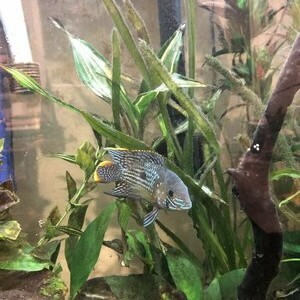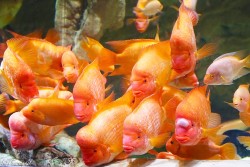The ultimate feeding guide for Andinoacara rivulatus of South America
 It's important to note that Green Terror Cichlids can be territorial and sometimes aggressive, especially during feeding. Be sure to monitor their behavior and, if you keep them in a community tank, ensure that other tankmates have access to food as well. Providing hiding spots and separate feeding areas can help reduce conflicts during feeding time. With a well-balanced diet and proper feeding practices, your Green Terror Cichlids can thrive and display their striking colors and patterns to their fullest. With their vivid emerald green and white patterning, imposing size, and feisty personality, green terror cichlids live up to their common name in captivity if not properly cared for. Native to river basins along the Pacific coast of Peru and Ecuador, green terrors inhabit tropical waters where they can grow up to 12 inches long. While juveniles make lively additions to community tanks, their eventual size and notoriously aggressive temperament demand large aquariums a minimum of 55 gallons and experienced keepers.
It's important to note that Green Terror Cichlids can be territorial and sometimes aggressive, especially during feeding. Be sure to monitor their behavior and, if you keep them in a community tank, ensure that other tankmates have access to food as well. Providing hiding spots and separate feeding areas can help reduce conflicts during feeding time. With a well-balanced diet and proper feeding practices, your Green Terror Cichlids can thrive and display their striking colors and patterns to their fullest. With their vivid emerald green and white patterning, imposing size, and feisty personality, green terror cichlids live up to their common name in captivity if not properly cared for. Native to river basins along the Pacific coast of Peru and Ecuador, green terrors inhabit tropical waters where they can grow up to 12 inches long. While juveniles make lively additions to community tanks, their eventual size and notoriously aggressive temperament demand large aquariums a minimum of 55 gallons and experienced keepers.Providing ample territory, tankmate compatibility, suitable water conditions, and a varied diet are keys to successfully keeping the green terror. Their stunning colors, attentive parental care, and fiery character fascinate aquarists dedicated to bringing out their best nature. When properly maintained, green terrors showcase just how enthralling, engaging, and downright beautiful so-called monster cichlids can be.

What do green terror cichlids eat exactly?
Green terror fish are very hardy eaters or omnivorous feeders. They should however be fed a balanced diet. This should include vegetable matter along with High-quality dry flakes and pellets, frozen, and live meaty foods. Live meaty foods are nice but expensive so this is not necessary. Frozen shrimps or prawns are welcomed. Are you looking for Green terror cichlids to buy?
How many times a day do I feed my green terrors?
Juvenile green terror cichlids should be fed 3 times per day but in small amounts. Its best to always keep them a little hungry. Don’t feed until they stop. Adult green terror cichlids should be fed 2 times per day but like juvenile cichlid fish, best to always keep them a little hungry. Remember over feeding is not good and it will produce more fish waste.
Recommended dry foods for Green terror cichlids?
This recommended guide for green terror cichlid dry foods includes veggies sticks, carnivore sticks, general pellets, bug bites, and krill. This provides a nice broad range of foods for health and growth.
YFS Veggie Supreme Sticks contains high amounts of veggie content. The perfect choice for veggie loving South American cichlids.
YFS Carnivore Sticks are a hearty sinking stick great for all of those bigger hungrier fish. To that we added kelp, spirulina and natural astaxanthin for great natural color.
NorthFin Cichlid Formula is professionally developed to improve the health and well-being of your Cichlids and other freshwater fish, while naturally enhancing their brilliant colors.
Fluval Bug Bites Cichlid Formula for Medium to Large Fish 3.5oz is specifically formulated to address the natural, insect-based feeding habits of fish, with added vitamins, minerals, and other trace nutrients important to their health and vitality.
NorthFin Krill Pro Pro Formula is easily digestible, slow-sinking pellets promote optimal nutrient absorption and help reduce the amount of waste in your aquarium.
Green Terror Cichlids are opportunistic feeders, which means they eat a wide range of foods, including:
High-Quality Cichlid Pellets: A staple in their diet, high-quality cichlid pellets provide essential nutrients and can be the primary source of nutrition.
Cichlid Flakes: Another common commercial food option, cichlid flakes are readily accepted and help provide a balanced diet.
Live or Frozen Foods: Green Terror Cichlids enjoy live or frozen foods such as brine shrimp, bloodworms, daphnia, and mosquito larvae. These foods offer variety and simulate their natural hunting instincts.
Chopped Vegetables: Occasionally, you can offer chopped vegetables like peas, spinach, and zucchini (blanched). These provide fiber and vitamins.
Carnivorous Options: They also appreciate small crustaceans, insects (in moderation), and even small fish.



